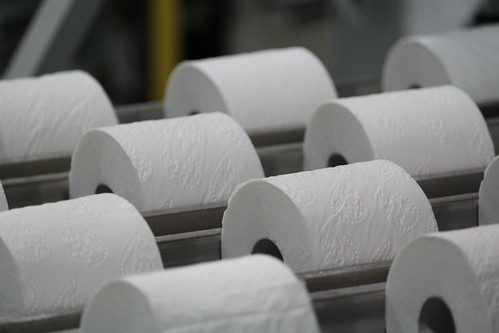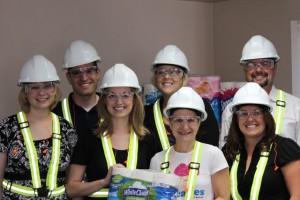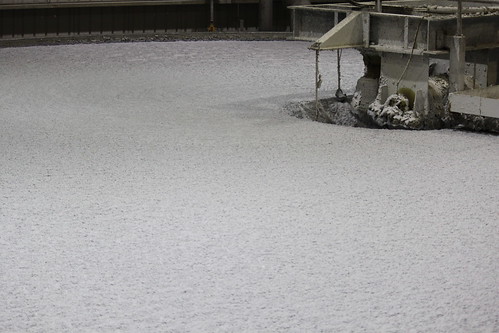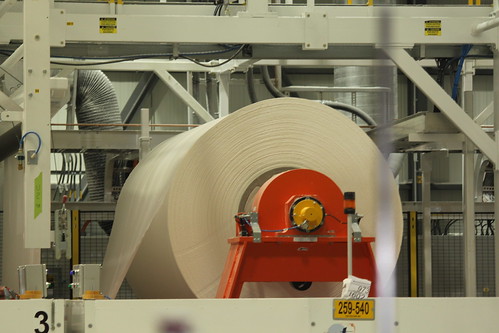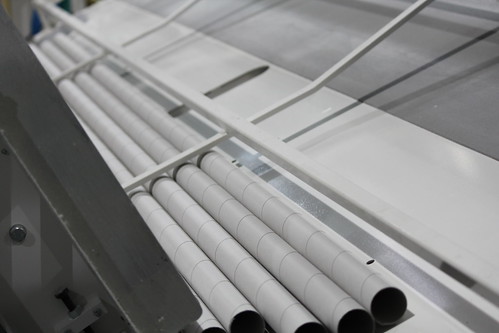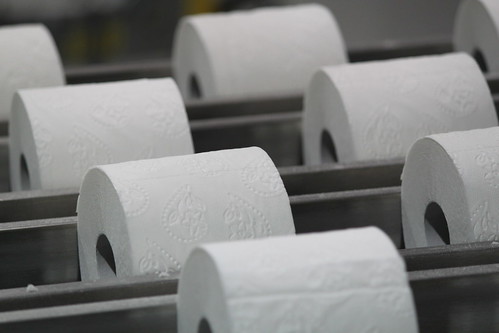A lot of folks in the paper industry are what you'd call, "Left Brain" folks. Here is a humorous story about a Left Brain person:
Tuesday, July 27, 2010
Tuesday, July 20, 2010
Thursday, July 15, 2010
The Fly, by JF
We were meeting in the new “Board Room.” It was outfitted in grand style, to suit the grand folks that were meeting there. A very large round table was in the center of the room. It is the largest round table you will ever see, maybe 12 feet in diameter. Our former main office had to be torn down because of a paper mill expansion in the mid 1980s. The meeting was with the construction and engineering “Firm” that we had hired to build the new paper machine. This meeting was to talk about the relatively small amount of expansion in the Kraft pulp mill and other lesser items. There were plenty of suits and yellow legal pads in evidence. I was there because some testing labs were to be combined in a passage way on the second floor over the road between an existing machine and the new machine. As an aside, when winter came, there had been no insulation in the floor of the lab and the temperature on the floor hovered around 40 degrees F. This caused much unrest.
The Firm had their chief Kraft mill guy giving the presentation, with plenty of backup. This person was really a good engineer and was well respected at our plant. He was in his late 40’s, I’d guess. He always wore a black suit and a 60’s era narrow black tie…the same one every time he came. I loved those ties and I admired the way he gave slide show presentations. He would say, “”This is slide one” and after a short pause with no other explanation, he would say, “This is slide two” etc. The whole show didn’t take long that way, what a relief. After the presentation, we broke for lunch.
When the meeting began again, a fly had entered the room. This was not easy as there were at least three doors to conquer. He was a normal southern black fly that we have all encountered at picnics, barbeques, homes etc. We know of his nimbleness and ability to escape death or even to be touched. His relative, the northern black fly, as in Maine , has the ability to stab you with his stinger which usually brings about his death because of his lack of nimbleness. This fly flitted about the board room, as flies do, and was shooed off by the back of many hands (note how we shoo flies). We all know where flies land and what he steps in and want none of it.
Eventually the fly landed in front of one of our engineers…Tom. He is a southern boy and had encountered flies all of his life. Carefully Tom’s hand formed the thumping position as the fly wandered around the yellow pad. I watched entranced. Soon the spring was sprung… and the fly disappeared; you know how flies can disappear in your house. Was it a hit or a miss? For a few seconds neither Tom nor I knew about the drama taking place; we were the only ones aware. Finally across the large 12-foot table, a Firm’s young engineer looked down and then straight up! What had killed a fly in the air? There he lay, apparently dead, on his yellow pad. The Firm’s engineer pulled the yellow pad, ever so slowly, off the table while watching to see if any one was watching. The poor dead fly was deposited on the carpet like a sailor buried at sea.
It was very, very hard to keep from laughing out loud in an otherwise somber meeting.
This was one of my more memorable meetings. Tom and I still laugh about it every time we see each other.
By JF
Wednesday, July 14, 2010
White Cloud
You find all kinds of interesting articles on the net.
How White Cloud Bath Tissue is Made + {Detained in Canada?}
by BRIANA CARTER on JULY 14, 2010 · 1 COMMENT
If you're new here, you may want to have these bargains delivered right to youremail or subscribe via RSS feed. If you are new to couponing, check out my series the "15 days of Couponing." Thanks for visiting!
As a White Cloud Blogger or as my blogging friends affectionately call me, a TP blogger, one of the perks was visiting a paper mill in Quebec, which was a very exciting trip for many reasons. First for my great welcome into the country by Canadian Immigration {sarcasm}, then for getting to spend time with a few of myfavorite bloggers, and lastly because yes, toilet paper production IS exciting.
The trip was not completely hampered by a slight detainment by Canadian Immigration officials, eh. Yes, I know I look threatening and like I’m totally visiting Canada to do something illegal. I’m sure they felt I was sketchy when I was said I was a blogger when asked what I was going to be doing in the country. Even more so when I said mom blogger. Maybe, blogging hasn’t reached Canada yet, eh?
Basically, instead of giving a simple answer to the simple question, “What will you be doing in Canada,” I gave a completely truthful yet rambling answer. Apparently the truth is makes you a suspicious character. Therefore, I was sent to a special area of immigration. Questioned extensively again, put in a separate room while they checked out my “story,” No, they couldn’t just hop onto to my website and visit theWhite Cloud Blogger.
I probably should have used the named Kruger Products or Cashmere since White Cloud is not sold in Canada. Who knows what they thought the White Cloud was.
While it felt like hours, it was probably a total of an hour I had to endure the cold silence. I was given no explanation at all why I was sent there. So of course, one might get a little teary eye from frustration and anger.
Apparently, my story checked out. I was released. However, the immigration official decided to give me a lecture that I couldn’t cry. I couldn’t be upset. Apparently, this is completely routine. So completely routine that I saw hundreds of people walking straight on through while only just three in this special area. Well, folks, my mama taught me that noone can tell you how to feel and I let this lovely welcoming committee of one know. I’m really surprised she handed me my passport back after I told her “No one can tell me how to feel. I can cry if I want to.” {Kind of feel like letting the Cyndi Lauper out every time I think of it!}
‘It’s not that common, it’s doesn’t happen to every traveler, and it is a big deal!’
Needless to say, the trip didn’t start out on the right foot as I was ready to go home and get the double hockey sticks out of Canada. This unpleasant start of my trip didn’t ruin my trip to Canada. Take that Immigration!
As soon as I was let free, I was able to meet up with our group and head to the Paper Mill. We were warmly welcomed by the Kruger Products staff, which is the company who manufactuer’s White Cloud Products for use in the United States and the leading manufacturer of tissue, towels, and bath tissue in Canada with well known brands such as Cashmere, Scotties, and White Swan. Let me say, their welcoming was much better than the lovely immigration officials.
 I’m looking back at my notes I took during the wonderful presentation and overview Steffan gave and I can barely read my own hand writing. However, I do remember the basics and took plenty of pictures to share with you.
I’m looking back at my notes I took during the wonderful presentation and overview Steffan gave and I can barely read my own hand writing. However, I do remember the basics and took plenty of pictures to share with you.Kruger Products, which was established in 1904, is a 5th generation family owned-corporation, which has a diversified portfolio. They go beyond just paper products, they have an Energy Division and Wine & Spirits among others. They employ over 9,000 employees in North America and Europe.
 Many of the products manufactured by Kruger, besides the White Cloud Green Earth products are made with recycled fibers. Kruger purchases most of the post consumer waste from the New York area and Eastern Canada.
Many of the products manufactured by Kruger, besides the White Cloud Green Earth products are made with recycled fibers. Kruger purchases most of the post consumer waste from the New York area and Eastern Canada.For those of you who are interested in the green aspect of White Cloud like Green and Clean Mom, you will be happy to know White Cloud can proudly claim the Terra Choice Certification. Because of their process of White Cloud Green Earth, which we were able to see but can’t show due to it being a trade secret, White Cloud Green Earth has a softer feel than other green bath tissue on the market.
For those of you who only use green bath tissue products, with White Cloud Green Earth you no longer have to suffer anymore because you will get a wonderful softness you can not get with any other green product on the market on top of a great low price!
Not only is the White Cloud Green Earth bath tissue far superior, Kruger is also working towards many goals to reduce waste, energy consumption, and emissions. All things that are great for the environment.
What I think is truly amazing about the entire bath tissue process is it only takes seconds to actually make it from start to finish.
It starts with paper.
Then it becomes a slushly mess with 95% water and 5% paper.
Then it gets rolled out flat into rolls like this, which received several hilarious comments from my Facebook Page. (Cuz if you were following me on Facebook, you had access to some of these fun pictures before I created this post!)
Then the rolls are stored like this…
These giant inner rolls are ready for the bath tissue to be added to it.
Then the rolls are cut so fast, you don’t even see it happening. It was so mesmerizing.
It is then packaged. The day we visited they were manufacturing Cashmere.
Overall, the trip was fun with wonderful people. I did not let that first hour of my time in Canada ruin the entire trip. Though, I doubt I will be making any voluntary trips back anytime soon!
The trip also reinforced my idea that White Cloud is a company I want to represent and want to work with. White Cloud is the only company in North America with the technology to support making a recycled paper product that is high quality AND reasonably price. White Cloud is truly the Smart Alternative.
Disclosure: White Cloud has compensated me for my time on this project. Rest assured, all opinions and thoughts are always my own. My goal as always is to help you save time and money. For more information read my disclosure policy.
Thursday, July 8, 2010
Did I Mention Roach? - Its Wild Bill
Roach was my 1968 VW mill car. Roach was painted dark blue. At that time [early 1980's] you did not drive a 'good car' to a paper mill. Now do not get upset because by the mid 1980's the paper industry had upgraded all systems and pollution was not an issue.
In 1984 we were in the middle of a major expansion which included a new paper machine, new boilers [state of the art pollution control] and, at that time, the world's largest mechanical pulping or TMP [thermo mechanical pulping] mill. I was the engineer for the new TMP Mill. Using today's dollars, the expansion would cost about $US1.2 Billion. We had 4,000 construction workers on site.
The TMP Mill used liquid SO2 [sulfur dioxide] to formulate sodium hydrosulfite bleaching liquor for bleaching TMP. The new system had two 13,500 gallon S02 tanks. Liquid S02 is as hazardous as chlorine gas. If one of the two new tanks failed, well, honestly say goodbye to about half of the county. In the previous year I had rebuilt the existing S02 system after researching the issues. I gave these specs to the project consulting engineers and directed these guys to duplicate the design. No such luck!
We filled one new S02 tank in the morning and at 2PM two days later this tank started to fail due to incorrectly specified gaskets. To truly experience an S02 leak you must go into your yard and pick up and put dog droppings into you mouth. The good news if you smell rotten eggs your are still alive! I called the chemical supplier and had two chemical tucks expressed to the mill. It was around 11PM when the tank was empty and danger had passed. Time to go home.
I started Roach and started to drive home. Fog had started to settle and when I began to turn off HWY 5, I missed judged my turn. I drove about 75 feet and started to turn left. At that instant I saw head lights in my right side door window. I then headed for the ditch on the right side of the road.
An off duty construction worker [from the project contractor] driving a step van rear ended Roach at about 70 MPH. Roach and I were launched about 50 feet before landing in the ditch. Poor Roaches engine ended up in the back seat! Yes he was dead!! I was alive but sore for days.
Roaches replacement? A 1974 Super Beatle painted orange named Tigger! I had Tigger's engine rebuilt and had him painted CLEMSON Orange. Now, no one could not say they did not see me ever again! All Yankees loved Tigger as he was a Southern Car with no salt damage. I sold Tigger to a young girl in Ohio in 2007 just before moving back south. She was only 12, but her Daddy said she just loved VW Beatles and would take good care of him.
FYI - My wife names everything we own. My Mercedes is named Scarlet, and my truck is named Buba. Oh yes, it was time to replace Roach!
Wild Bill - Alive and Well!
Wednesday, July 7, 2010
Tuesday, July 6, 2010
You've Got To Move Fast Just To Keep Up!
The water cooler wisdom blog has an interesting post today on communication. Check it out. You might learn something:
How to Communicate Across Generations
In every talk I give at a corporation or conference on intergenerational communication, someone raises their hand and says that people of different generations don’t vary in their styles and that it’s all in my head. If you’re tempted to think that, here are some examples of the types of remarks I’m always hearing:
Born before 1945, they’re the loyalists, the ones who spent a lifetime at the company and expect to be rewarded with a Rolex:How can I help YOU?Flexibility is a code word for less work getting done.If I’m not yelling at you, you’re doing fine.
Baby Boomers
Born 1945-63, they’re the hippies and the yuppies, the ones who worshiped the Beatles and clawed their way to the top:
I paid my dues to get more money, a better title, and a swankier office – what are you going to do?You’ll get your feedback, that’s what annual performance reviews are for.We’ve been in business for 50 years, we must be doing something right.
Generation X
Born 1964-79: they’re the loners, the ones who learned to be self-reliant while their parents left them with latchkeys:
Company loyalty – what’s that?I can manage my own career, thank you very much.Give me the skills or give me death.
Millennials
Born 1980-95, they’re the techies, the ones whose parents taught them they were special and entitled:
Sorry to interrupt, but you haven’t told me how I’m doing in the last hour.Let’s cut out the red tape and cut it out now.How can YOU help ME?
You can see that when it comes to communication, we’ve come full circle from the customer-oriented traditionalists, who wanted to know how they could help you, to the self-focused Millennials, who want to know what an organization and its people can do for them.
Adapting your style to suit the different perspectives of the multi-generational workforce will increase your team’s productivity and support a stronger sense of loyalty and positive morale. Here are some ideas to start you off:
Traditionalists
- Empower traditionalists to make their own decisions by encouraging them to “trust their gut” and supporting them in whatever they determine is the best course.
- Have deference for their years of experience and listen. After all, what has happened in the past is the best predictor of what will happen in the future.
- Talk to traditionalists about their learnings and their long-term plans. Don’t assume they have one foot out the door just because they’re what used to be retirement age.
- Provide constructive feedback as you would to any other employee – they can and should learn new tricks.
Boomers
- Give recognition whenever possible. Acknowledge Boomers’ contributions and be cognizant about implementing their suggestions.
- Encourage them to mentor younger colleagues and learn new skills and technologies so that they can continue to hone their potential.
- Allow them to experiment with their jobs. Many Boomers are getting antsy and want to do work that’s different and more personally meaningful.
- Respect the status quo. Boomers feel that if it ain’t broke, don’t fix it. Don’t insist on change for its own sake.
X-ers
- Share your unique expertise. X-ers are interested in amassing as much training and knowledge as possible.
- Look to X-ers as team leaders. They have been chomping at the bit to be out of the Boomers’ shadow for years and are ready for their time to shine.
- Use technology to make team meetings easier. Many X-ers have families to think about, and they appreciate you keeping their necessary work/life balance in mind.
- Don’t block their path to decision makers. X-ers just want to get the work done and can get impatient with turf wars and too many bureaucratic channels.
Millennials
- Take Millennial employees out to lunch and inquire about their career goals and aspirations. They want to feel like you care.
- Explain to Millennials why things are done a certain way in your organization, educate them on who they need to talk to to get things done, and spell out “unwritten” rules to ensure compliance.
- Have an open-door policy in which you are available for Millennial team members to ask questions and receive guidance. Provide constructive feedback in real time.
- In the event of a crisis, don’t shut them out because of their status as junior team members. Millennials love the apprentice approach and will learn so much from having the opportunity to work by your side.
This post was originally published on Intuit's Quickbase blog.
Monday, July 5, 2010
The Paper Mill, 1953-1954 - by JF
They led me to an enormous room that contained a huge machine. I’d never seen anything like it. As an “Extra Board person”, I was almost overwhelmed. It was hot and the noise level was high and there was a characteristic smell that turned out to be hot linerboard. It smelled the same in all the other linerboard plants that I was ever in. The machine was running fast - very fast! Rolls of paper were spewing out and rolling across the floor. Men were grabbing them and on painting numbers with a stencil and then pushing them onto a little metal conveyer in the floor where they moved off to somewhere else. This turned out to be my job – stenciling and pushing rolls around. The work was not hard but was constant. I didn’t get to eat lunch or do any exploring.
The plant had begun operations in 1939, when a lap pulp machine moved there from West Virginia . In the ‘50’s, there were three machines making linerboard, corrugating medium and milk carton. The pulp machine was gone. The mill was doing just fine and was pushing 2000 employees. Later a fourth machine making a hardwood free-sheet was added. Now, in 2010, there is one machine operating, I’m told, and it is run by a Canadian Company.
A horn started blaring. All of the men ran to the other end of the machine and began crawling all over it which now had parts shut down. It looked dangerous. There had been a break. I asked a man whom I later found out was the foreman, what I could do. He said don’t get in the way … I didn’t. Eventually the sheet got through the machine…by magic I think. The last step was the men threw the paper into stacked set of steel rolls with a stick….more magic. We all went back to work. Soon there was another break and I ran down to the other end and watched again.
Later the foreman came back and asked me if I wanted to work over (overtime) to change the wire. That was time and a half. It was enough for a week and a half in college time. Two and a half weeks counting the first shift. I said sure.
I had no idea what a wire was. I was thinking of a long telephone–like wire that was on a roll and required several men (and a boy) to roll up. I found out what it was; people moved the machine out of the (screen-like) wire, then put the machine back into the new wire. My job was to hose down everything in sight for eight hours. A few years later I found out it included hosing young process engineers that happened to be walking by.
The foreman was a Georgetown (SC) person. There were an amazing number of Georgetown people in southern mills at that time. These folks had started in Georgetown , SC or came through there in the 30’s,through the 70’s and maybe longer. Most of the people did very well.
The paper industry in the US ran full during those years and delivered good paying jobs for tens of thousands of pulp and paper and forestry workers and their families. I couldn’t wait to get in school to learn what I was doing.
JF
Subscribe to:
Posts (Atom)
